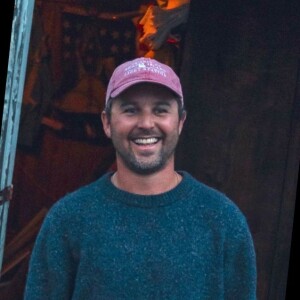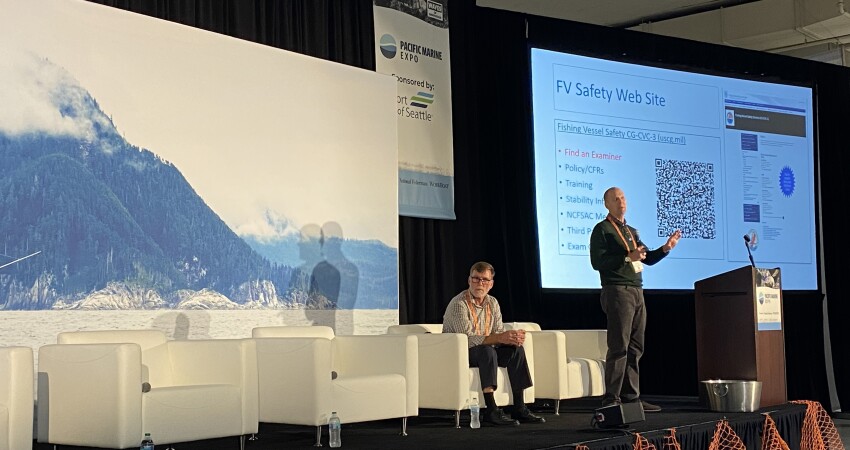The U.S. Coast Guard (USCG) presented its "Fishing Vessel Safety Program Updates" seminar during day two of the Pacific Marine Expo. The session detailed challenges and partnerships aimed at improving safety within the commercial fishing industry, also providing a look at the Coast Guard’s work on policy enforcement, marine casualty analysis, and outreach.
Joseph Myers, Chief of the USCG’s fishing vessel safety division, began the session outlining the program’s reach. “We have roughly 36,000 commercial fishing industry vessels in the U.S. That’s a mix between domestic state vessels and those over five net tons, which are documented vessels,” he said.
The Coast Guard’s involvement extends internationally, representing U.S. interests at the International Maritime Organization (IMO). “We help drive initiatives such as watchkeeping, the STCW (Standards of Training, Certification and Watchkeeping for Seafarers), and the Cape Town Agreement,” Myers explained, emphasizing the USCG’s role in shaping international safety standards.
At the domestic level, the Coast Guard monitors the implementation of legislation. “If there’s a law or an Authorization Act that comes out, we comment on draft legislation, follow it through, and enforce it through outreach, guidance, or other means.”
Addressing marine casualty statistics, the USCG discussed trends in fatalities and vessel losses. “As you can see, we had a very high spike this year, 24 fatalities and 26 vessel losses. We want that number to be zero, obviously.”
Despite the spike, long-term data shows a downward trend in incidents since the 1980s, which the Coast Guard attributes to “a combination of regulations, outreach, and partnerships with industry and agencies such as NIOSH (National Institute Occupational Safety and Health).”
The analysis of marine casualties drew from various contributing factors. “Sometimes it’s weather, sometimes we’ve exceeded safe loading conditions, or we didn’t foresee icing during a storm,” Myers explained. “A lot of times, it’s situational awareness—or even substance abuse. And many times, these factors dovetail into each other.”
The Coast Guard highlighted its collaboration with the National Commercial Fishing Safety Advisory Committee, a panel of 18 industry representatives, including fishermen, insurers, and safety experts, who review marine investigations which lead to safety recommendations. The recommendations often lead to updated best practices and guidance aimed at reducing risks.
Dockside safety exams remain a cornerstone of the Coast Guard’s program. “Boots on the deck, in our view, make the vessel a lot safer,” Myers explained. In 2024, over 3,000 vessels met the high standards outlined in the Part 28 exam checklist, which covers areas like firefighting, lifesaving equipment, and stability documentation.
For operators, the Coast Guard provides resources to prepare for exams. “We’re modernizing our website to include examiner contact info, training materials, and advisory committee updates,” he said. A new tool will soon allow operators to input vessel details and receive a tailored list of requirements for dockside exams. “If anything, it sets you up for success.”
The Coast Guard reiterated its commitment to reducing casualties, concluding the session with a harrowing success story provided by Harvey Hamm, staff member of the Coast Guard’s fishing vessel safety division. Hamm spoke to the importance of preparation in life-threatening situations. He described a case involving a fishing vessel off the Gulf Coast of Florida during Hurricane Milton. The vessel broke down in severe weather, and when the crew called the Coast Guard for help, they were told that the storm conditions were too dangerous for a rescue mission.
“The answer the watch stander gave them was, ‘We can’t come out. We suggest you put your life jacket on and grab your EPIRB.’ That’s not the answer anyone wants to hear,” Hamm recalled.
“So the gentleman put his life jacket on, and he grabbed his EPIRB. The boat obviously went down. And my thought was, we lost this individual.” Hamm noted that once Hurricane Milton subsided, the USCG was able to rescue him from a Good Samaritan vessel that picked him out of the water.
Hamm concluded with a call to action for continued collaboration. “We’ve lost another member of our community recently due to entanglement, and the fishing community is talking about it. Let’s keep working together because, at the end of the day, we want everybody to come home. It’s doable, but it’s going to take everybody.”







